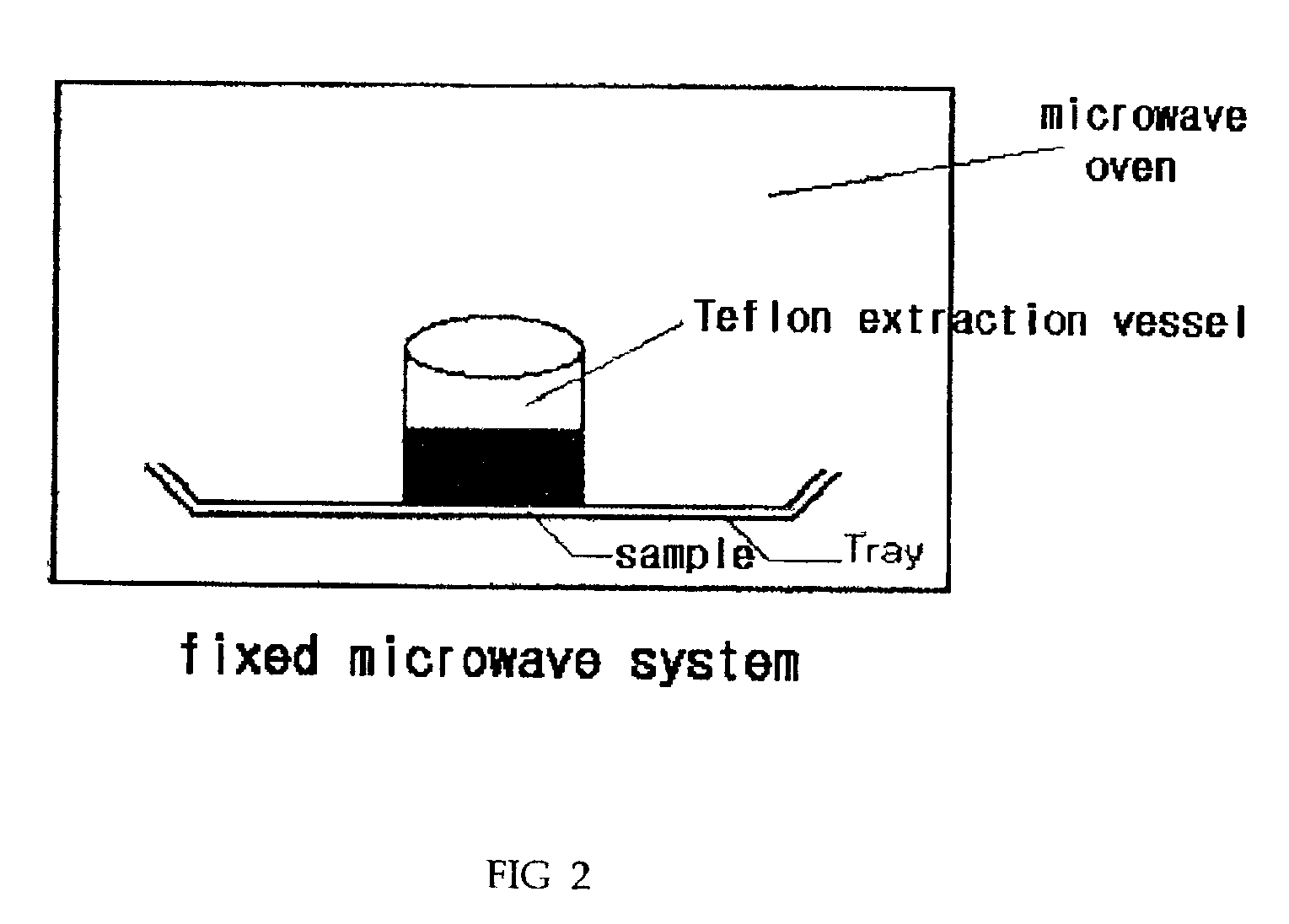Process for extracting astaxanthin pigment from yeast and extracted pigment thereof
a technology of astaxanthin and pigment, which is applied in the field of extracting astaxanthin pigment from yeast and extracting pigment thereof, can solve the problems of low bioavailability of astaxanthin powder manufactured without such treatment, hardly tried extraction of astaxanthin from crustacea, etc., and achieves the effect of easy diffusion into the cell
- Summary
- Abstract
- Description
- Claims
- Application Information
AI Technical Summary
Benefits of technology
Problems solved by technology
Method used
Image
Examples
example 1
Pigment Extraction Yield Test According to Continuous or Fixed Microwave Treatment System
[0033] The extraction yield of astaxanthin was measured under microwave illumination according to the conditions; microwave output 50.about.1,000 watts, at frequency of 916 or 2450 MHz, for 10.about.500 seconds. Cultivated yeast cells (concentration: 10 g / L) were treated with microwave by i) continuous microwave treatment system using the Teflon tube as shown in FIG. 1 and ii) fixed microwave treatment system using the Teflon extraction vessel as shown in FIG. 2. 10 vol. part of ethanol was added to 1 vol. part of cultivated yeast suspension. After extraction at 30.degree. C. for 24 hours, the extract was laid at -20.degree. C. for more than 30 minutes to remove the lipid. After centrifuging obtained extract using centrifuger (10,000.times.g), the astaxanthin extract was obtained by concentrating the supernatant at reduced pressure. To measure the extraction yield of pigment, absorbance was meas...
example 2
Pigment Extraction Yield Test According to Extraction Solvent and Time After Microwave Irradiation
[0043] According to the method in Example 1, frequency 2450 MHz; output 500 watts; and irradiation time 60 seconds were adjusted for microwave treatment. The cultivation suspension has cell density of 10 g / L. The amount of extraction solvent was 10 vol. part compared to 1 vol. part of cultivated suspension. The extraction temperature was at 30.degree. C. The astaxanthin extract was obtained by using rotary vacuum evaporator followed by agitation in the dark room. After adding acetone, the absorbance of pigment extract was measured at 478 nm. Finally, pigment extraction yield was measured using UV / VIS Spectrophotometer Biochrom 4060.
[0044] Table 2 shows the result of pigment extraction yield and pigment destruction rate according to the variation of solvent and time. All results are mean values of three times experiments.
2 TABLE 2 Extration Extraction time (hour) solvent 0 6 12 18 24 Con...
example 3
Pigment Extraction Yield Test According to Cell Density of Cell Cultivation Suspension at the Time of Microwave Irradiataion
[0045] The experiment was carried out as the same manner of Example 2 except that cell densities of cell cultivation suspensions were varied. The cell density of cell cultivation suspension was evaluated by the dried weight of yeast cells per liter. Finally, pigment extraction yield and pigment destruction rate were measured using UV / VIS Spectrophotometer Biochrom 4060.
[0046] Table 3 shows the result of pigment extraction yield and pigment destruction rate according to cell density of cell cultivation suspension at the time of microwave irradiation. All results are mean values of three times experiments.
3 TABLE 3 cell density (g / L) Extraction yield (%) 5 94(3) 10 95(4) 50 91(7) 100 86(9) 200 90(7) ( ): pigment destruction rate unit: %
PUM
 Login to View More
Login to View More Abstract
Description
Claims
Application Information
 Login to View More
Login to View More - R&D
- Intellectual Property
- Life Sciences
- Materials
- Tech Scout
- Unparalleled Data Quality
- Higher Quality Content
- 60% Fewer Hallucinations
Browse by: Latest US Patents, China's latest patents, Technical Efficacy Thesaurus, Application Domain, Technology Topic, Popular Technical Reports.
© 2025 PatSnap. All rights reserved.Legal|Privacy policy|Modern Slavery Act Transparency Statement|Sitemap|About US| Contact US: help@patsnap.com



